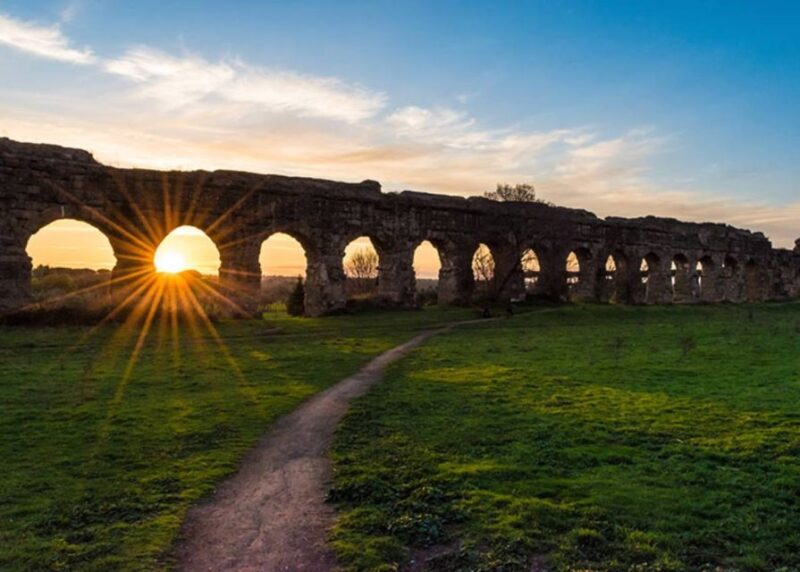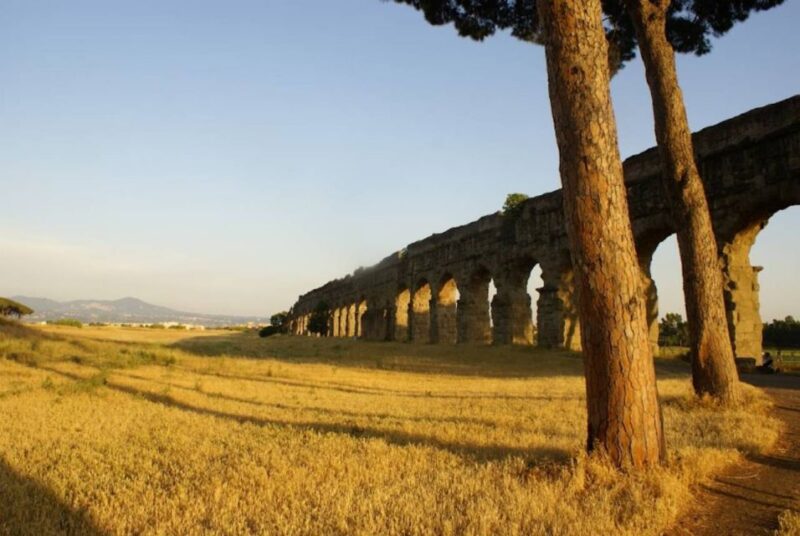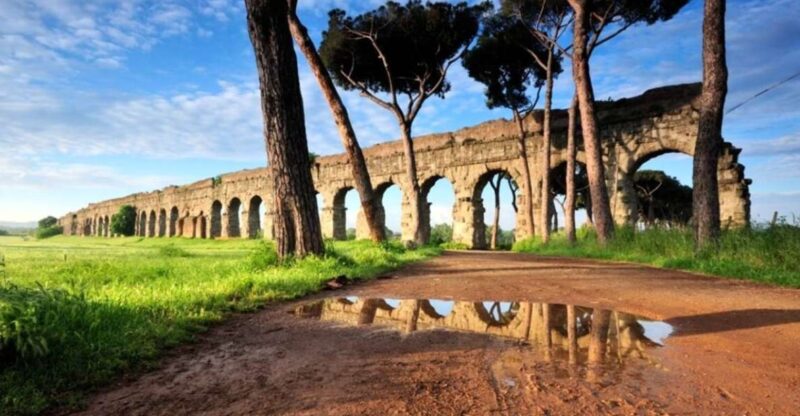The ancient aqueducts of Rome stand as a testament to the city’s engineering prowess. These impressive structures, spanning over 90 kilometers, transported fresh water from distant sources to sustain the capital’s growing population. Utilizing gravity-fed systems and intricate arched designs, the aqueducts showcased the Romans’ mastery of hydraulic engineering. Yet, their vulnerability became apparent during invasions, when damage to this vital infrastructure threatened the city’s survival. Exploring these aqueducts offers a unique glimpse into the challenges and ingenuity that shaped Rome’s development over the centuries.
Key Points

- The tour offers a 2-hour guided exploration of four remarkable ancient Roman aqueducts, some standing over 20 meters high.
- Visitors can engage in hands-on experiences, including touching the ancient masonry and taking photos from various angles.
- The tour emphasizes the historical significance of the aqueducts, which were critical for supplying water to the Roman Empire.
- Insights are provided into the engineering feats and vulnerabilities of the aqueducts, which were susceptible to damage and disruption during invasions.
- The tour takes place in a local park, offering a unique off-the-beaten-path experience for an intimate and engaging encounter with Rome’s architectural legacy.
Tour Overview

For this guided tour of ancient Roman aqueducts, participants can expect an immersive 2-hour experience.
The activity is priced from $106.13 per person and is available in English, Italian, and Spanish.
Group size is limited to 10 participants, making it an intimate affair.
The tour is wheelchair accessible, and free cancellation is allowed up to 24 hours in advance.
Highlights include discovering the history of the Roman Empire, walking on aqueducts over 20 meters high, and learning about the construction and significance of these engineering marvels that span over 90 km.
You can also read our reviews of more tours and experiences in Rome.
Experience and Highlights

The tour begins at the ODStore Roma Tuscolana, located within the Parco degli Acquedotti.
From there, participants explore four remarkable Roman aqueducts, some standing over 20 meters high.
Along the way, the guide shares the fascinating history of the Roman Empire’s reliance on these engineering marvels, which once spanned over 90 km.
Visitors can touch the ancient structures and take photographs, gaining a hands-on understanding of the aqueducts’ construction and significance.
The highlight is walking atop the aqueducts, offering a unique perspective on Rome’s past and its vulnerability during invasions.
This off-the-beaten-path experience provides an intimate look at a part of Rome’s history often overlooked by travelers.
Exploring the Aqueducts

Exploring the four remarkable Roman aqueducts that dot the Parco degli Acquedotti provides visitors with a captivating journey back in time.
Towering over 20 meters high, these ancient structures offer a hands-on encounter with Rome’s engineering prowess. Guests can walk along the aqueducts, touch the weathered stone, and marvel at their sheer scale.
The tour guide shares fascinating insights into the construction, function, and historical significance of these vital water systems that once spanned over 90 kilometers.
Visitors gain a deeper appreciation for the aqueducts’ role in sustaining the Roman Empire and their vulnerability during invasions.
This off-the-beaten-path experience allows guests to explore a local park and witness the enduring legacy of Rome’s architectural genius.
Construction and Significance
Towering over 20 meters high, the ancient Roman aqueducts in the Parco degli Acquedotti stand as remarkable feats of engineering.
These colossal structures, spanning over 90 km, were critical to supplying water to the burgeoning Roman Empire. Constructed using a combination of stone, brick, and concrete, the aqueducts showcased the Romans’ mastery of hydraulic engineering.
They utilized gravity-fed systems and intricate arched designs to transport millions of gallons of water daily. The aqueducts’ vulnerability during invasions underscores their vital significance, as the city’s very survival depended on these impressive waterways.
Today, these architectural wonders offer visitors a unique glimpse into Rome’s rich history and the engineering prowess of its ancient builders.
More Great Thing To Do NearbyOff the Beaten Path
Venturing off the beaten path, the Ancient Aqueducts of Rome tour offers visitors a unique opportunity to explore a park frequented by locals.
This off-the-grid experience provides a hands-on encounter with Rome’s historical structures, allowing participants to touch and take photos of the ancient aqueducts.
Key benefits of this tour include:
- Immersion in a local park, away from the crowded tourist hubs
- Ability to interact directly with the historical structures
- Insight into Rome’s reliance on aqueducts and their vulnerability during invasions
- Expert Guided Tour of Colosseum Arena OR Underground, and Forum
- Tuscany Region Day Trip From Rome With Lunch & Wine Tasting
- Colosseum Underground and Ancient Rome Small Group – 6 People Max
- Skip-the-Line Vatican, Sistine Chapel & St. Peters | Small Group
- Vatican Museums, Sistine Chapel & St Peter’s Basilica Guided Tour
- Gladiator’S Gate: Special Access Colosseum Tour With Arena Floor
Hands-on Experiences
The hands-on nature of the Ancient Aqueducts of Rome tour allows visitors to truly enjoy the historical structures. Guests can touch the weathered stones, peer through arches, and capture photos from unique vantage points. This interactive experience brings the aqueducts to life, fostering a deeper understanding of their construction and significance.
| Hands-On Experiences | Description |
|---|---|
| Touch the Aqueducts | Run your fingers along the ancient masonry |
| Take Photographs | Capture the aqueducts from various angles |
| Explore the Park | Wander the paths and discover hidden corners |
| Engage with the Guide | Ask questions and learn insider details |
This intimate, small-group tour provides an unparalleled opportunity to connect with Rome’s engineering marvels.
Reliance and Vulnerability
Rome’s ancient aqueducts were the lifeblood of the city, providing a critical supply of fresh water for centuries.
However, this vital infrastructure also made the city vulnerable to invaders.
The aqueducts:
- Stretched over 90 km, making them susceptible to damage and disruption.
- Were often targeted during sieges, leaving the population without water.
- Relied on a complex system of arches and channels, which could be easily compromised.
Despite their vulnerabilities, the aqueducts were a testament to the engineering prowess of the Roman Empire, and their legacy continues to shape the city’s water supply to this day.
Practical Information
Visitors planning to explore Rome’s ancient aqueducts can find practical details that will help make the most of their experience.
The guided tour lasts 2 hours and costs $106.13 per person, with availability in English, Italian, and Spanish. Groups are limited to 10 participants, and the tour is wheelchair accessible.
Free cancellation is allowed up to 24 hours in advance. The meeting point is at the Metro Station "Giulio Agricola" – A Line, in front of the OD Store’s Shop, where guides wearing white hats with the association’s logo will be present.
After the tour, visitors can enjoy typical Roman cuisine.
Frequently Asked Questions
Can I Bring My Pet on the Tour?
No, pets are not allowed on this tour. The tour is limited to 10 participants and is designed for a small group experience exploring the ancient Roman aqueducts. Accessibility is provided, but pets are not permitted.
Is There an Age Limit for Participants?
There’s no age limit specified for the tour. Children are welcome to participate, though the 2-hour duration and walking may not be suitable for very young kids. The tour is open to all adults and families.
Do You Offer Any Discounts for Students or Seniors?
There are no specific student or senior discounts offered for this guided tour. However, the tour operator may be willing to provide a discount for group bookings of 6 or more participants. Interested parties should inquire directly with the tour provider.
Can I Extend the Tour Duration for an Additional Fee?
Yes, you can extend the tour duration for an additional fee. The tour operator offers the flexibility to customize the experience to meet your needs, including extending the duration beyond the standard 2 hours.
Is Photography Allowed During the Tour?
Yes, photography is allowed and encouraged during the tour. The guide will provide ample opportunities for participants to capture the stunning aqueducts and learn about their history up close.
Recap
The ancient aqueducts of Rome were engineering marvels that sustained the city’s population for centuries. Their construction showcased the Romans’ mastery of hydraulic engineering, but their vulnerability also highlighted the vital importance of this infrastructure to Rome’s survival. Exploring these remarkable structures offers visitors a glimpse into the city’s vibrant past and the ingenuity of its people.
You can check if your dates are available here:More Tour Reviews in Rome
- Dark Heart of Rome: Facts, Legends, and Mystery Tour
- Rome: Colosseum & Forum With Audio Guide App -Optional Arena
- Dark Heart of Rome – Facts, Legend & Mystery Walking Tour
- Rome: Colosseum, Ancient Rome Tour or Self AudioGuided Tour
- Rome: Trevi Fountain, Spanish Steps & Pantheon Walking Tour
- Rome: Basilica of San Clemente, San Giovanni, and Scala Santa
Not for you? Here's more things to do in Rome we have recnetly reviewed
- Rome: Trastevere and Jewish Ghetto Highlights Tour
- Vatican City: St. Peters Basilica Walking Tour
- Rome: City Highlights Small Group Walking Tour by Night
- Rome: Castel SantAngelo Skip-the-Line Entry Ticket
- Rome: Skip-the-Line Castel SantAngelo Tickets & Audio Guide
- Rome: Treasure Hunt for Kids and Families Trevi and Pantheon
- Secrets of the Passetto: Vaticans Hidden Path of Mystery
- Rome: Jubilee Pilgrimage Walking Tour
- Rome: In-Depth St. Peters Basilica Tour With Tour Guide
- Rome: Trastevere & Tiber Island Street Food Tour at Sunset
- Rome:St. Peters Basilica Tour, Exclusive Underground Access
- Rome: Castel Sant’ Angelo Ticket and Audio Guide
